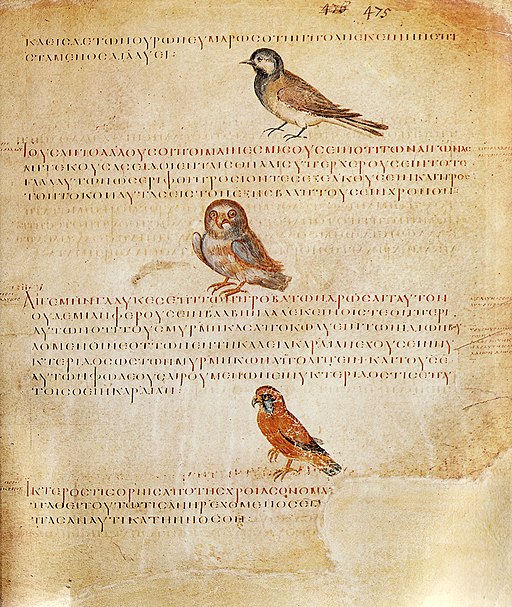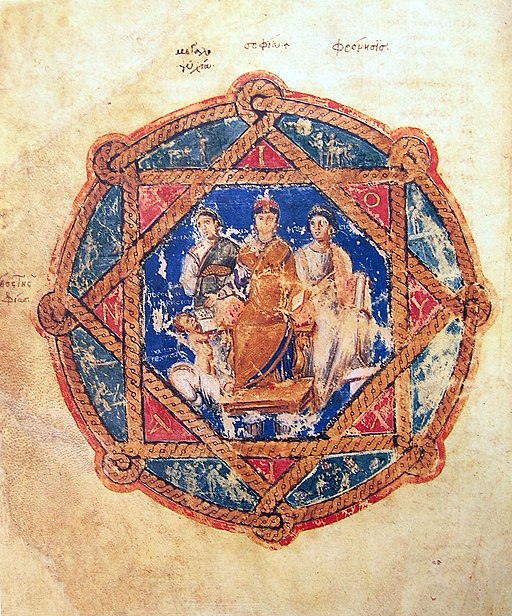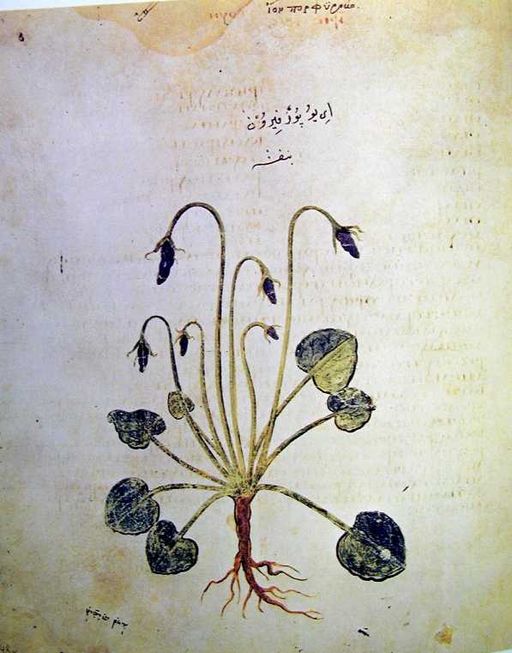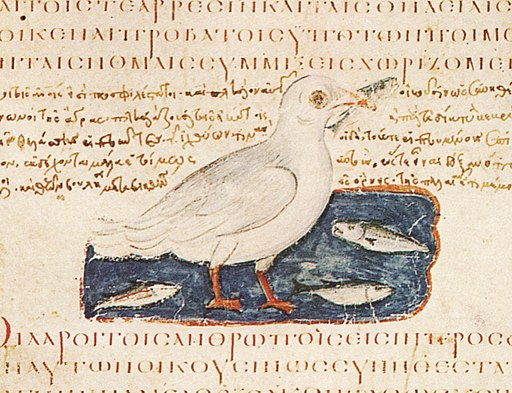
The Vienna Dioscurides is a Byzantine Greek illuminated manuscript copy of “Medical Material” by Dioscorides, which was created in 515 AD. It is a rare surviving example of an illustrated ancient scientific and medical text.
The original “De Materia Medica” or “On Medical Material” was first written between 50 and 70 CE by Pedanius Dioscorides. It is a pharmacopeia of medicinal plants and was widely read and used for more than 1,500 years.
This specific manuscript copy was created in the Byzantine Empire’s capital, Constantinople, for the byzantine imperial princess, Anicia Juliana. She was the daughter of Anicius Olybrius, who had been one of the last Western Roman Emperors.
The manuscript was presented to the princess in gratitude for her funding the construction of a church in Constantinople. The dedication miniature portrait of Anicia Juliana is the oldest surviving dedication portraits in a book.
The portrait has Anicia seated in a ceremonial pose distributing alms. Personifications of “Magnanimity” and “Prudence” flank her. At her feet, another representation, labeled “Gratitude of the Arts,” kneels.
Anicia Juliana (462 – 528) spent her life at the pre-Justinian court of Constantinople, where she was considered the most aristocratic and the wealthiest inhabitant.
The inclusion of the personifications and the putti, shows the endurance of the classical tradition in Constantinople, even though the city and princess were Christian.

Portrait of Anicia Juliana as donor seated between two personifications, Magnanimity and Prudence.
The Vienna Dioscurides, also called Juliana Anicia Codex, has 491 vellum folios measure 37 by 30 cm and contain more than 400 illustrations of animals and plants, most done in a naturalistic style.
The majority of the illustrations were painted naturalistically to help pharmacologists to recognize each plant.
This manuscript is also the oldest surviving illustrated treatise on birds. The birds portrayed throughout the treatise are easily identifiable.
In later centuries, the codex was used daily as a textbook in the imperial hospital of Constantinople. A medieval note records that a Greek nurse at the hospital had it rebound in the early 1400s.
Throughout the Byzantine period, the manuscript was also used as the original for copies of the work that were given to foreign leaders.
Copies were made in Arabic for Abd al-Rahman III of Spain after the Byzantine Emperor Constantine VII sent a Greek copy and a translator.
The manuscript was restored and a table of contents and extensive scholia added in Byzantine Greek minuscule, by the patriarchal notary John Chortasmenos in 1406.
In the mid-1400s, it was used to create the “Pope Alexander VII Dioscorides,” now in the Vatican Library, by the monks of St. John the Baptist Greek orthodox monastery in Constantinople.
After the fall of Constantinople in 1453, a subsequent owner handwrote each plant’s name in Arabic and Hebrew.
The manuscript, still in Istanbul a century after the fall of the city, was purchased from the Arabic-speaking, Jewish physician to Sultan Suleiman the Magnificent, by a Flemish diplomat employ of Emperor Ferdinand I of the Austrian Habsburgs.
After residing in Constantinople for a thousand years, the text passed to the Holy Roman Emperor in Vienna in the 1500s.

Illustration from the Vienna Dioscurides
– After the fall of Constantinople in 1453,
a subsequent owner handwrote each plant’s name in Arabic and Hebrew.
Pedanius Dioscorides – De Materia Medica
Pedanius Dioscorides (40–90 AD) was a Greek physician, pharmacologist, botanist, and author of “De Materia Medica” or “On Medical Material,” a 5-volume Greek encyclopedia about herbal medicine and related medicinal substance.
De materia medica was widely read for more than 1,500 years, making it one of the longest-lasting of natural history books.
The work describes many drugs, including aconite, aloes, colocynth, colchicum, henbane, opium, and squill. About 600 plants are covered, along with some animals and mineral substances, and around 1000 medicines made from them.
Dioscorides had a significant and long-lasting effect on Arabic medicine as well as medical practices across Europe. “De Materia Medical” was one of the first scientific works to be translated from Greek into Arabic.
Dioscorides studied medicine at the school in Tarsus. His pharmacopeia refers almost solely to plants found in the Greek-speaking eastern Mediterranean.
The name Pedanius is Roman, suggesting that an aristocrat of that name sponsored him to become a Roman citizen.
Vellum
Vellum is prepared animal skin or “membrane,” typically used as a material for writing on. Parchment is another term for this material.
Vellum is prepared for writing to produce single pages, scrolls, or codices and was used for all the great uncial codices.
Vellum is generally smooth and durable, although significant variations are dependent on the preparation and the quality of the skin.
The manufacture involves the cleaning, bleaching, stretching, and scraping of the skin. A final finish may be treating it with lime or chalk to make it accept writing or printing ink.
Modern “paper vellum” is made of synthetic plant material, and is called such for its usage and quality similarities.

Uncial script
Uncial is a script written entirely in capital letters commonly used from the 4th to 8th centuries AD by Latin and Greek scribes. Uncial letters were used to write Greek, Latin, and Gothic.
Early forms are characterized by broad single stroke letters using simple round forms taking advantage of the new parchment and vellum surfaces, as opposed to the angular, multiple-stroke letters, which are more suited for rougher surfaces, such as papyrus.
In the oldest examples of uncial, all of the letters are disconnected from one another, and word separation is typically not used. Word separation, however, is characteristic of later uncial usage.
Uncial was still used, particularly for copies of the Bible, tapering off until around the 10th century. There are over 500 surviving copies of the uncial script.
Juliana Anicia Codex and the Ravenna Mosaics
Vienna Dioscurides – Juliana Anicia Codex
- Title: Vienna Dioscurides or Vienna Dioscorides
- Also: Juliana Anicia Codex, Codex Vindobonensis
- Date: 515 AD
- Culture: Byzantine
- Writing: Byzantine Greek
- Materials: Vellum
- Dimensions: 491 vellum folios measure 37 by 30 cm
- Type: Ancient Texts
- Museum: Österreichische Nationalbibliothek in Vienna
Virtual Tour of Ancient Texts
- Gilgamesh Flood Tablet – 7th century BCE
- Lament for Ur – 1800 BC
- Law Code of Hammurabi – 1754 BC
- Book of the Dead – Papyrus of Ani and Hunefe – 1250 BCE
- Cyrus Cylinder – 539–538 BC
- The Rosetta Stone – 196 BC
- Vindolanda Tablets – 1st-century
- Codex Vaticanus – 300–325
- Vienna Dioscurides – Juliana Anicia Codex – 515
- Blue Qur’an – 9th – 10th century
- Miroslav Gospel – 1186
- Hadith Bayad wa Riyad – 13th-century
- The Belles Heures of Jean of France, Duke of Berry – 1405
Virtual Tour of Historically Influential Books
- Code Noir – 1687
- “Common Sense” by Thomas Paine – 1766
- “Poems on Various Subjects, Religious and Moral” by Phillis Wheatley – 1766
- Gardner’s Photographic Sketchbook of the Civil War – 1863
- Ancient Texts and Historically Influential Books
History of Pedanius Dioscorides
De materia medica – Il Dioscoride di Napoli
~~~
“Let food be thy medicine and medicine be thy food.”
– Hippocrates
~~~
Photo Credit: 1) Unknown author / Public domain; Anthémios de Tralles / Public domain
Popular this Week








 Sponsor your Favorite Page
Sponsor your Favorite Page SEARCH Search for: Search Follow UsJoin – The JOM Membership Program
Sponsor a Masterpiece with YOUR NAME CHOICE for $5
Share this:
- Tweet
